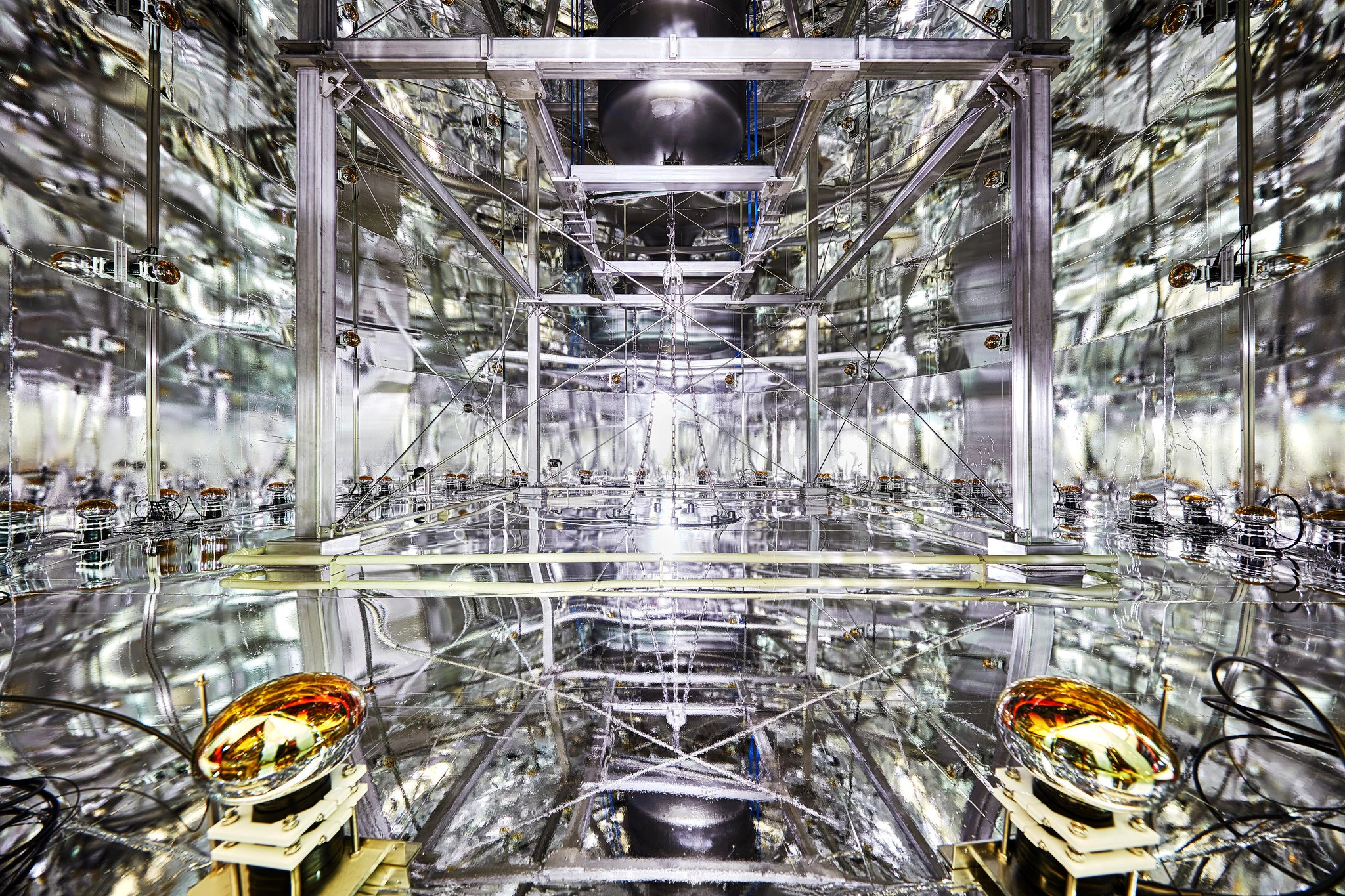IEA XERD-0vbb
XEnon Time Projection Chambers: R&D for Future Generation Experiments and Probing Non-Standard Mechanisms of Neutrinoless Double Beta Decay (0vbb)IEA XERD-0vbb
2022 – 2023
Contact: Sara DIGLIO
sara.diglio@subatech.in2p3.fr
02.51.85.86.33
Australian partner : Professor Elisabetta Barberio
NEWS
MCN Network
Melbourne-CNRS Network 1st Symposium (6/7th of December 2021) – Presentation
Introduction
Dark matter searches and studies of neutrino properties are one of the main priority areas of particle physics, astrophysics and cosmology worldwide. Neutrinos measurements give strong indications that this particle plays a central part in the evolution of our matter-dominated universe. A crucial piece of this puzzle is to establish experimentally if neutrinos, contrary to all other fermions particles, is its own antiparticle (Majorana particle) through measurements of very rare nuclear decays. With this project we aim at investigating the nature of neutrinos probing non-standard mechanism of neutrinoless double beta decay with the XENONnT experiment and study the future perspectives with the next generation DARWIN detector. Moreover, we plan to invest on a prototype development of a xenon time projection chamber for R&D studies for DARWIN.
.
Context of the study
The Standard Model (SM) is currently our best theory of elementary particles and their interactions. It describes the interaction between fundamental particles and forces. No theory in human history has been confirmed to greater precision. As successful as the SM is, it cannot be a complete theory of the universe at the smallest scale. The first experimental evidence of this was the discovery that neutrinos have a very small, but non-zero, mass by the Super-Kamiokande collaboration; a measurement that has since been confirmed by several other experiments. These results are strong indications that neutrinos play a central part in the evolution of our matter-dominated universe. A crucial piece is to establish experimentally if neutrinos, contrary to all other fermions particles, is its own antiparticle (Majorana particle) through measurements of very rare nuclear decays.
The most sensitive probe for the Majorana nature of neutrinos is an extremely rare nuclear decay process called neutrinoless double beta decay (0ν2β), where a nucleus with mass number A and charge Z decays by emitting two electrons and changes its charge by two units (A,Z)–>(A,Z+2) + 2e-. The observation of 0ν2β puts direct constraints to the absolute neutrino mass scale and provide valuable information on how neutrino masses are generated. The detection of 0ν2β decay will prove that neutrinos are Majorana particles. If the neutrino were found to be a Majorana particle, it will be the first Majorana particle found to exist.
In addition, the detection of 0ν2β decay would provide direct evidence of process that violates lepton number conservation. Evidence of lepton number violation (LNV) can explain why matter dominates over anti-matter in our universe. There exist mechanisms of 0ν2β decay where the LNV is necessary and a large fraction of these can be tested using an Effective Field Theory (EFT) approach. These theoretical models can thus be used as a low-energy test of new physics phenomena that complements high-energy searches at the Large Hadron Collider.
Single and dual phase xenon (Xe) time projection chambers (TPCs) are among the most promising technologies for the proposed research: they have recently demonstrated their exceptional capabilities for rare event detection, including 0ν2β decay. Notably, the Xe is one of the handful isotopes that can undergo 0ν2β decays (136Xe), whose natural abundance is quite high (~9%).
The SUBATECH Xenon Group is strongly involved in dark matter (DM) and 0ν2β searches within the international XENON collaboration, which is currently commissioning the XENONnT dual phase Xe TPC. On a longer-term timescale, the group is contributing to the R&D and sensitivity studies of a next generation experiment for DM & 0ν2β, DARWIN. Besides, the team members designed, realized, installed and are currently testing in Nantes, an original single phase Xe TPC prototype for medical imaging purposes, XEMIS.
Main objectives of the project
The main objectives of this project are:
- To investigate the nature of neutrinos by probing non-standard mechanism of 0ν2β with XENONnT and DARWIN experiments;
- The realization of a Xe TPC prototype for an R&D for DARWIN.
The first objective is fulfilled by the strong interplay between the expertise of the SUBATECH members in detector simulations & data analysis techniques combined with the UoM expertise in theoretical modelling and data interpretation. An EFT approach will be used to constrain LNV operators and to interpret experimental results. This will be the first time that non-standard mechanisms of 0ν2β will be tested on data issued by a XENON experiment! In parallel, projections on the sensitivity of the DARWIN experiment on these same mechanisms will be also investigated for the first time.
Expertise and complementary of partners
The School of Physics of the University of Melbourne (UoM) has a strong expertise in theoretical modeling and data interpretation: its activity comprehends the search for DM, collider physics, matter-antimatter asymmetry and physics beyond the SM, including the search for Majorana neutrinos and LNV scenarios. The school hosts the ARC Centre of Excellence for Dark Matter Particle Physics and is part of a universities consortium that support the Stawell Underground Physics Laboratory (SUPL). SUPL will start operation by 01/2022. SUPL has initiated a vigorous DM direct detection experimental program and there are plans to extend its physics program to neutrino physics. Moreover, UoM intend to join the DARWIN consortium in the near future.
The proposed project fits perfectly the strategic goals of both institutes to enhance the international exchange and collaboration along common interests on detector R&D and 0ν2β search. The SUBATECH expertise is complementary to that at UoM: the first has undisputed competences in single and dual phase Xe TPCs as well as 0ν2β decay analysis, the latter has a strong expertise on signal modelling, data mining and data acquisition systems (DAQ) of large-scale experiments. A PhD student (starting in 10/2021), a CNRS/in2p3 Postdoc (starting in 01/2022) and a UoM Postdoc will integrate the expertise of the two groups enabling key elements of the project.
Network activity and expected results
This program will provide France and Australia with an outstanding opportunity to participate in an exciting project of international significance in frontier physics. The collaboration will result in a better understanding of neutrino properties trough the search of non-standard mechanism of 0ν2β decay with XENONnT data and projections for the next generation DARWIN experiment. Additionally, a Xe TPC prototype for R&D studies on the DARWIN detector will be realized. The project will lay the foundation for a first common infrastructure and effective network of knowledge focused on common interests on astrophysics rare-events search and Xe-based detector R&D. We expect that both groups -and the XENON & DARWIN collaborations too- will benefit from this exchange of expertise. This same infrastructure may be used in the future for others DARWIN R&D programs that will involve German partners in the context of the CNRS-Helmholtz Association International Research Laboratories (IRL) network.
Institutions and laboratories involved
France
UMR6457 Laboratoire de Physique subatomique et des technologies associées – SUBATECH (CNRS/IMT Atlantique/Université de Nantes)
Australia
Southern Underground Physics Laboratory (ARC Centre of Excellence for Dark Matter Particle Physics) (University of Melbourne, Melbourne)

Intérieur d’un château d’eau de Xenon1T, qui protège le détecteur des rayons cosmiques © Enrico Sacchetti/XENON Collaboration

